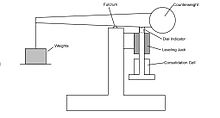- Oedometer test
-
An oedometer test is a kind of geotechnical investigation performed in geotechnical engineering that measures a soil's consolidation properties. Oedometer tests are performed by applying different loads to a soil sample and measuring the deformation response. The results from these tests are used to predict how a soil in the field will deform in response to a change in effective stress.
Contents
Concept
Oedometer tests are designed to simulate the one-dimensional deformation and drainage conditions that soils experience in the field. To simulate these conditions, rigid confining rings are used to prevent lateral displacement of the soil sample. Porous stones are placed on the top and bottom of the sample to allow drainage in the vertical direction. To better simulate one-dimensional strain, a diameter-to-height ratio in the sample of 3:1 or more is used. Because the process of consolidation involves movement of water out of a soil, it is important to prevent drying of the soil.[1]
History
Consolidation experiments were first carried out in 1910 by Frontard. A thin sample (2in thick by 14in in diameter) was cut and placed in a metal container with a perforated base. This sample was then loaded through a piston incrementally, allowing equilibrium to be reached after each increment. To prevent drying of the clay, the test was done in a room with high humidity.[2]
Karl Terzaghi started his consolidation research in 1919 at Robert College in Istanbul.[2] Through these experiments, Terzaghi started to develop his theory of consolidation which was eventually published in 1923.
The Massachusetts Institute of Technology played a key role in early consolidation research. Both Terzaghi and Arthur Casagrande spent time at M.I.T. - Terzaghi from 1925 to 1929 and Casagrande from 1926 to 1932. During that time, the testing methods and apparatuses for consolidation testing were improved.[3] Research was continued at MIT in the 1940s by Donald Taylor.[4]
Testing procedures
There are many oedometer tests that are used to measure consolidation properties. The most common type is the Incremental Loading (IL) test.[1]
Incremental Loading
The text Soil Mechanics in Engineering Practice describes a general procedure for the Incremental Loading test. A stiff confining ring with a sharp edge is used to cut a sample of soil directly from a larger block of soil. Excess soil is carefully carved away, leaving a sample with a diameter-to-height ratio of 3 or more. Porous stones are placed on the top and bottom of the sample to provide drainage. A rigid loading cap is then placed on top of the upper porous stone. This assembly is then placed into a loading frame.
Weights are placed on the frame, imposing a load on the soil. Compression of the sample is measured over time by a dial indicator. By observing the deflection value over time data, it can be determined when the sample has reached the end of primary consolidation. Another load is then immediately placed on the soil and this process is repeated. After a significant total load has been applied, the load on the sample is decreased incrementally. Using a load increment ratio of 1/2 provides a sufficient number of data points to describe the relationship between void ratio and effective stress for a soil.[1]
ASTM International has a standard testing procedure for incremental loading: ASTM D2435-04.[5]
Results
Oedometer tests provide engineers with very useful data about the soil being tested.
Consolidation Properties
- Preconsolidation Pressure σ'p[6]
- The effective stress that marks the boundary between stiff and soft deformation response of a soil to loading
- Usually indicative of high loadings in the past from glaciers or eroded layers
- Recompression Index CR = Δe/Δlogσ'v[7]
- How the soil will change volume (settle) under loads less than the preconsolidation pressure
- Can be used to approximate swelling due to unloading
- Compression Index CC = Δe/Δlogσ'v[7]
- How the soil will change volume (settle) under loads greater than the preconsolidation pressure
- Duration of Primary Consolidation tp[8]
- Secondary Compression Index Cα = Δe/Δlogt[8]
- How the soil will change volume (settle) under a constant loading
See also
References
- ^ a b c Terzaghi, Karl; Peck, Ralph; Mesri, Gholamreza (1996). Soil Mechanics in Engineering Practice (3rd Edition). (Article 16.9) Wiley-Interscience
- ^ a b Bjerrum, Laurits; Casagrande, Arthur; Peck, Ralph; Skempton, Alec. (1960). From Theory to Practice in Soil Mechanics. (p44) John Wiley & Sons, Inc.
- ^ Bjerrum, Laurits; Casagrande, Arthur; Peck, Ralph; Skempton, Alec. (1960). From Theory to Practice in Soil Mechanics. (p6-7) John Wiley & Sons, Inc.
- ^ Taylor, Donald W. (1942). Research on Consolidation of Clays. Massachusetts Institute of Technology
- ^ ASTM International. ASTM D2435 - 04 Standard Test Methods for One-Dimensional Consolidation Properties of Soils Using Incremental Loading. http://www.astm.org/Standards/D2435.htm
- ^ Terzaghi, Karl; Peck, Ralph; Mesri, Gholamreza (1996). Soil mechanics in Engineering Practice (3rd Edition). (Article 16.4) Wiley-Interscience
- ^ a b Terzaghi, Karl; Peck, Ralph; Mesri, Gholamreza (1996). Soil mechanics in Engineering Practice (3rd Edition). (Article 16.6) Wiley-Interscience
- ^ a b Terzaghi, Karl; Peck, Ralph; Mesri, Gholamreza (1996). Soil mechanics in Engineering Practice (3rd Edition). (Article 16.7) Wiley-Interscience
Categories: - Preconsolidation Pressure σ'p[6]
Wikimedia Foundation. 2010.

